Some gardeners allow their tomato plants to sprawl across a given space which can work fine.
However, if you want to put more thought into growing tall tomato plants or having a smaller garden, you can use many types of support.
Each type of support is designed to help you create a high-yielding tomato plant that you can manage and maintain effectively.
If you allow your tomatoes to grow unsupported, there is a growing possibility of accidental damage.
Your kids or a domestic pet can easily knock over a tomato plant or some of its yield, and even some high winds can quickly curtail a growing plant.
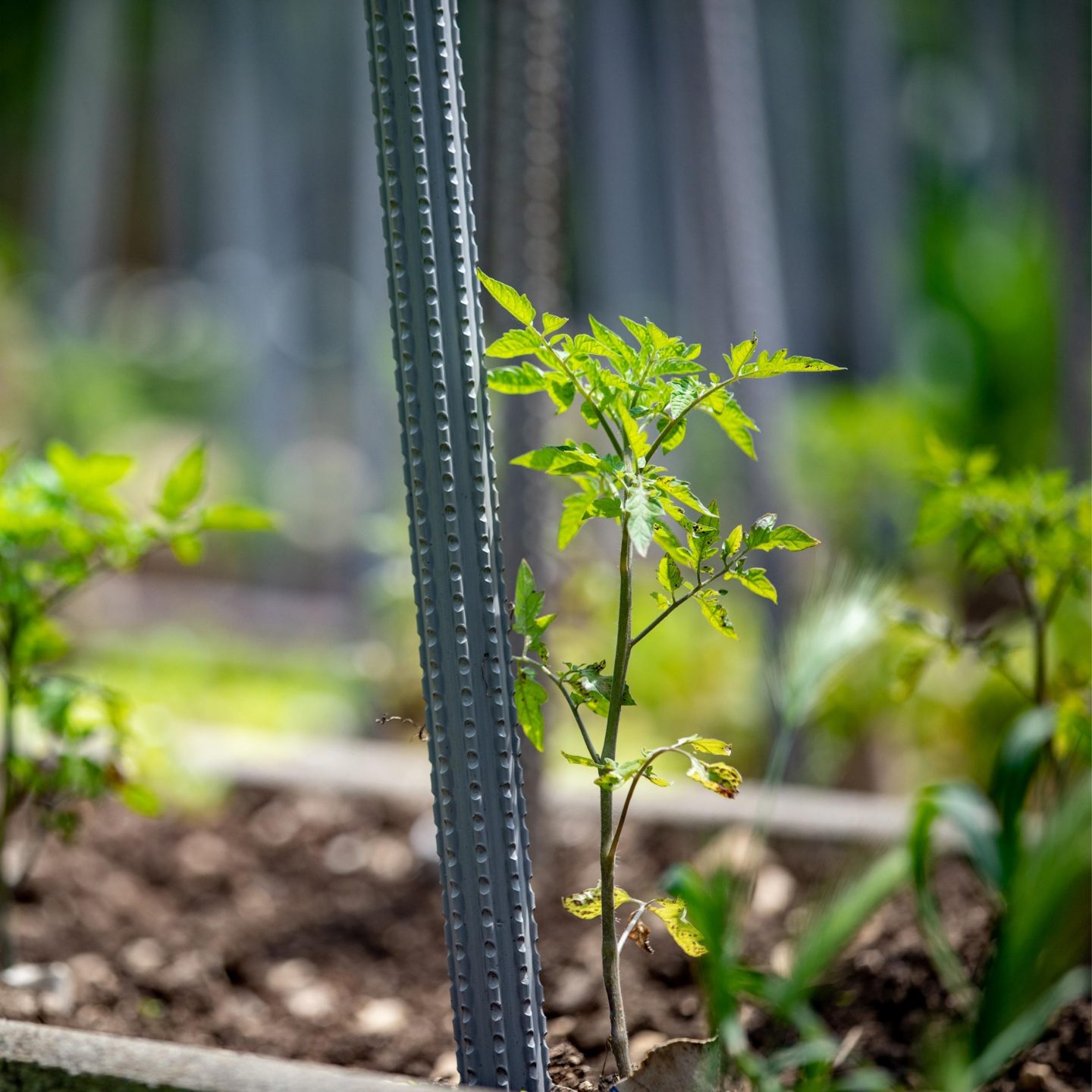
There are also soil-borne pathogens and fungal diseases that can affect your plant if it does not grow from an elevated position.
From smaller tomato cages to simple stakes or a trellis for easier harvesting, the proper support can work for a tomato plant or tomato vines and can be installed quickly.
Tomatoes tend to have an upright growth habit, which means they can be put in danger if exposed to the elements.
By supporting tomatoes, the plants can grow strong with unbroken main stems and a bountiful fruit yield which you can enjoy as your own food.
Tomato Cages
For ready-made tomato support that you can pick up at a garden store, try tomato cages. These can be cylindrical or made from square wire and keep your tomato plants upright without you needing to tie the stems.
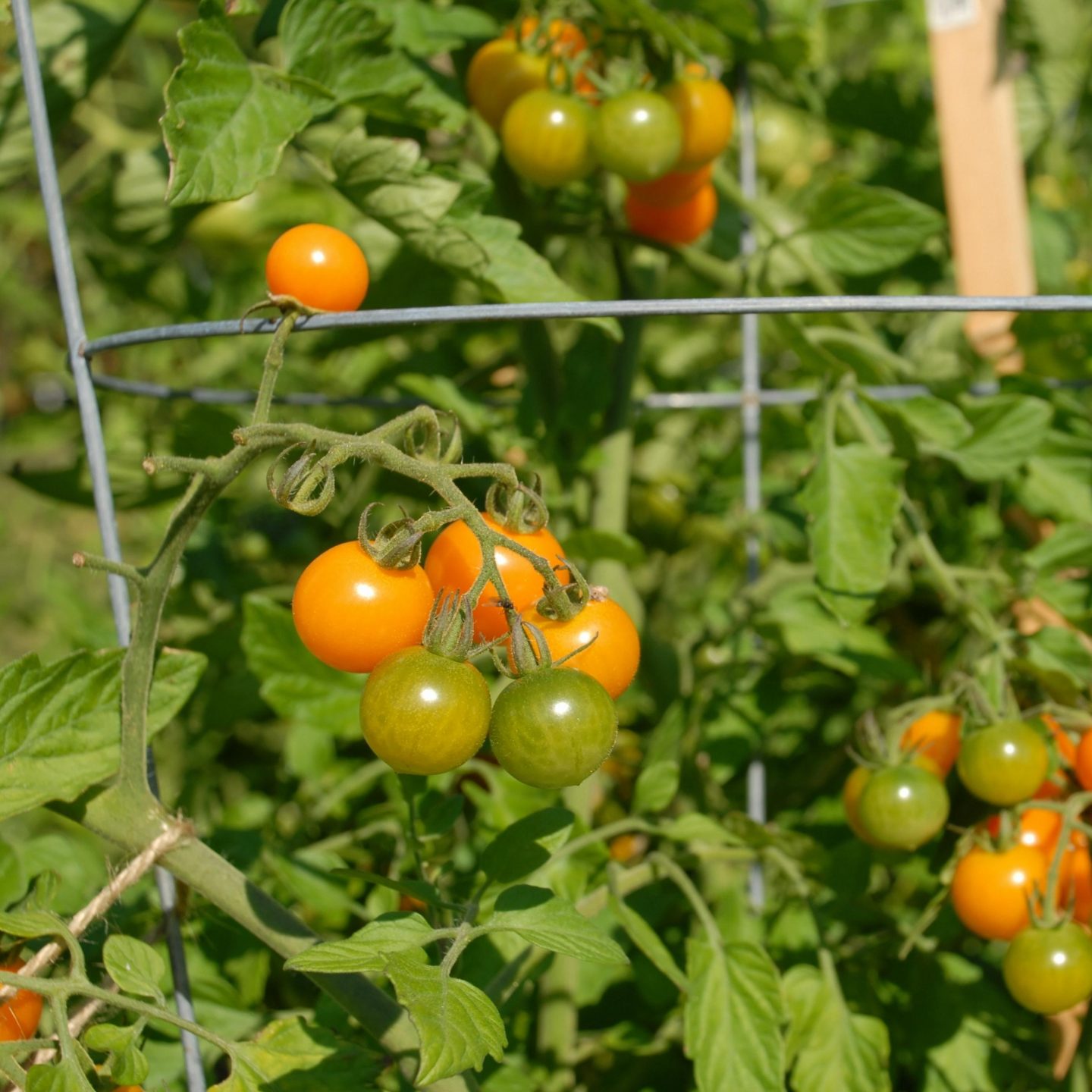
However, tomato cages can be deemed flimsy, and harvesting may become complicated, yet they provide some welcome support up to a point as they may only work up to a specific height.
In addition, you may want to consider combining the cage with wooden stakes deep into the ground to prevent your heavy duty tomato cages from toppling to the ground if your garden is exposed to windy conditions.
There are several tomato cages to choose from in a garden store, and the different types include those made from wood and wire or sturdy metal and even a Tomato Tower Obelisk.
The Trellis
One of the most popular types of tomato support is the trellis which can help tomato plants grow efficiently. This support is great for maximizing space as you can grow the tomato plants vertically yet keep them together.

This is my DIY Wooden Garden Obelisk and it is beyond fantastic for supporting high yield, heavy vegetables like tomatoes.
For growing tomatoes upright, the trellis is perfect for tomatoes, and as the plants use up that space, that efficiency also means increased air circulation surrounding the foliage.
Instead of being crowded up as the tomato plant grows, they benefit from being drier and less vulnerable to fungal diseases or soil-borne pathogens.
As the growth of tomatoes is directed and promoted upward, the tomato plant, including its fruit and leaves, also benefit from increased exposure to sunlight. When grown on a trellis, the fruit is also more accessible, making harvesting effortless.
You can also check the plants easier for pests or diseases as they will be increasingly visible and easier to reach, thus improving the fruit quality and keeping the fruit clean.
There are different versions of a trellis you can use, so you should ask yourself whether you have the DIY skills to make your own or if you should buy one.
DIY Tomato Support Trellis
With a DIY tomato support trellis, you are in control.
The trellis can be as large or petite as you want, plus you can decide on the natural materials to use for a more rustic charm. You could even make use of some discarded materials as this is a great way to recycle.
Natural Branch Trellis
The trellis can come in different shapes and be made from natural branches. Even the fallen branches in your garden from your own tree can be used. Weave in the branches, then tie them together with some natural twine or string.
Depending on the size of the branches, you may want to check out some of the neighbor's gardens to gain a wider variety.
Not only can you make this trellis however you want, but you will also only be spending your time, and they can be easily dismantled once you have used them.
Pallet Wood Trellis
Pallet wood is occasionally found in warehouses and is exceptionally sturdy, ideal for tomato plants and heavier fruits. As soon as you have grown your latest batch of tomatoes, use the same structure for pumpkins or squash.
Bamboo Trellis
You could also try to make a bamboo trellis from bamboo canes. You can weave together bamboo canes and tie them with natural twine like the natural branches.
Bamboo can add more versatility by being a straighter material to use. There is also the likelihood that the bamboo is easier to use than tree branches that are irregular in shape and covered in moss.
Fishing Net Trellis
There are excellent materials that you can repurpose for your DIY tomato trellis. If you live close to the coast, or even if you do not, try to find some fishing nets that you can reclaim.
The nets can be simply hung on your fence or wall, even spread on a wooden frame, to help support the growth of your tomato plants once you tie them in with some twine.
Not only will you be putting the net to good use by keeping the tomatoes off the ground, but you will be helping to tackle plastic pollution too.
Chicken Wire Trellis
If you want to increase the sturdiness of your tomato trellis, then there are other materials you can use with the wood. One such useful material is a heavy gauge wire or chicken wire which can be stapled inside the wooden frame.
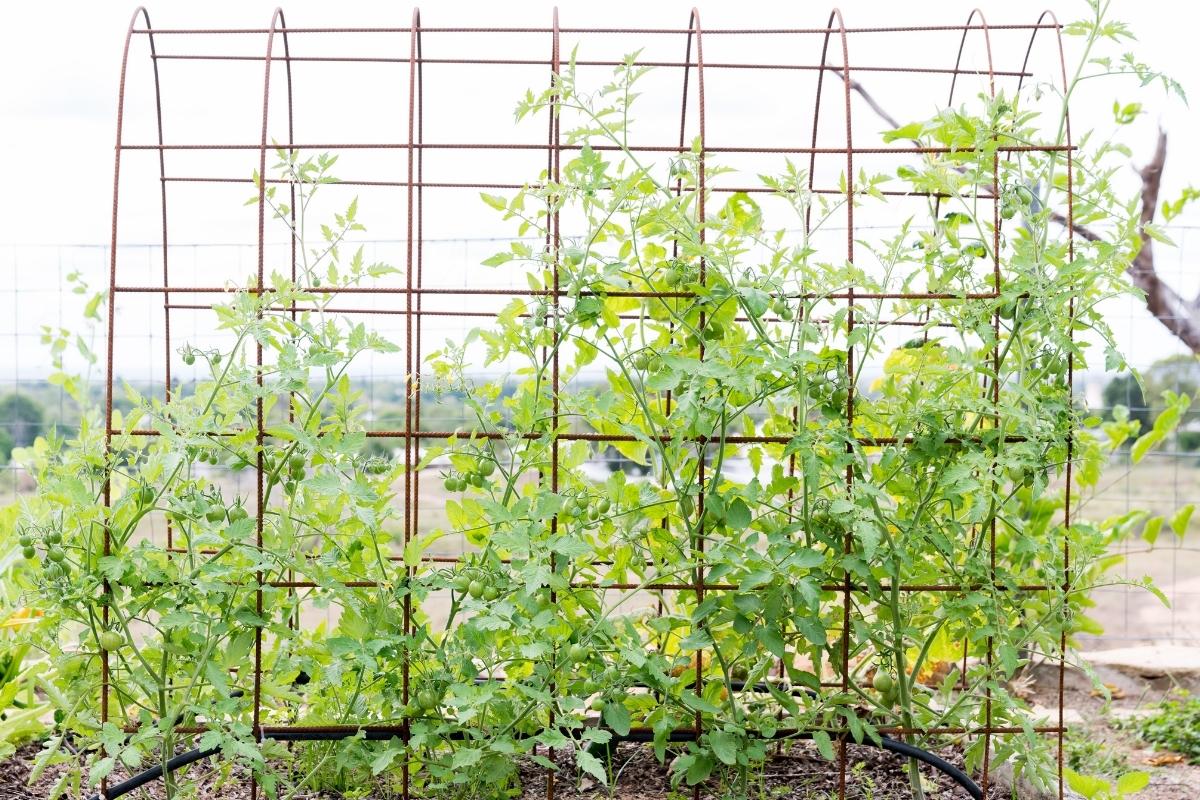
The wire can also be placed upright or against a fence if you do not want it to be freestanding to give your tomato plant the support it needs.
Piping Trellis
You can recycle some old piping for a quirky and sturdy tomato trellis.
Instead of a complete trellis structure that you may have to design then create, find some old pipes with the correct lengths that you require.
If they are too long, you can always see them down to the right size. This is another support method that can be used for various fruits and vegetables to keep them off the ground.
Prop the pipes up against the wall or your fence then you can affix some heavy gauge wire to act as spokes. You could also use some old bicycle wheels to use the spokes as anchor points to tie on your tomato plants.
Not only are you recycling another material and helping the environment, but the display can add a different look to your garden that may prove eye-catching to neighbors.
DIY Tomato Cages
Tomato cages can be easily constructed. Below are a few ideas you could try, from upcycling an old stepladder or some metal fences to simply weaving together some branches or bamboo canes to just using some chicken wire.
Chicken Wire Tomato Cage
Try bending some chicken wire into a circle to provide your tomatoes with some malleable yet firm support.
Woven Branch Tomato Cage
Head to some nearby woods, and you can recycle some fallen branches to weave together as support to your tomatoes. You may even have a tree in your backyard that may need pruning too.
Upcycled Stepladder Obelisk
Instead of some natural wood, if you have a stepladder that you no longer use, stand it up, attach some bars that traverse the sides, and let your tomatoes find their own support.
Metal Fencing Tomato Cage
Like chicken wire, you can bend some metal fencing for some large tomato plants.
Bamboo Tomato Cage
Bamboo canes are able to withstand some extreme weather conditions and can be reinforced in a tipi structure or as a box cage.
Wooden Stakes
This is another option to apply some DIY know-how, yet you could always buy your wooden stakes from a store.
Pick up some 2x2x8 framing lumber from a home improvement store and use it with an open-faced cage to create a structure where you can tie on your tomato plants with some twine or fabric.
The good thing about wooden stakes is that you can buy them in various sizes. If they prove too big, you can easily trim them down too.
However, one drawback is that you do have to maintain the tying of your tomato plant, though do remember that this is a cheap method.
Florida Basket Weave
For a cheap and effective way to use trellis-based support for growing your tomatoes, try a Florida Basket Weave. You can use this technique with a raised bed as the method uses twine to hold up your plants gently.
The tomato plants are essentially sandwiched between those lengths of the string, so you do not need to use any clips or stakes.
This versatile support method can be used with determinate and indeterminate tomato varieties when the plants are below two feet tall.
They should be easy to manage, and you can remove them from their gardens, but make sure that you mulch the soil beds before planting them.
The weaving system can control the tomato plants at that early age though it may become more complex with larger, more wild plants.
Cordon Support
If you have limited support in your yard, try a cordon system that uses tailored support wires, stakes, or canes. These encourage tomato plants to grow in a tall, individual stem which may be ideal for indeterminate plants.
A-Frame Cordon Frame
Create your own reinforced cordon using three long stakes connected to form a frame in the shape of an A.
Square Cordon Frame
Using four stakes, you can connect each corner and hang your wires from it for some spacious tomato growing. If the frame can support them, perhaps hang some plants in containers with a hole in the bottom to allow them to grow upside down.
Final Thoughts
Planning out your garden is an effective way of making sure you use all the available space.
Support for your tomato plants should produce better quality tomatoes and higher yields. This is mainly due to elevating the plants and fruit from the ground, reducing the chances of rot.
With better air circulation and fewer leaves getting wet, you can also prevent the disease from spreading across your tomato plants.
In addition, as the plants and fruit are higher, they are easier to prune and quicker to yield than those grown on the ground.
Tomato supports can prove to be an exceedingly wise investment given tomatoes produce tomatoes throughout the year. And, I'm confident you'll find that canning fresh garden tomatoes is extremely rewarding.
Ideas for Tomatoes
Here at Cottage at the Crossroads we try to delivery garden to table. You'll find definitive guides on planting tomatoes, garden structures, delicious recipes and of course canning recipes.

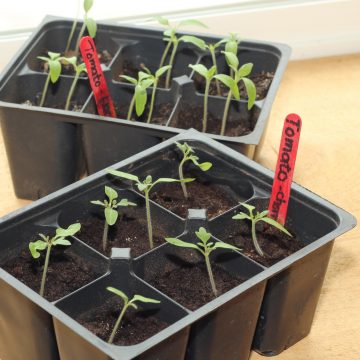
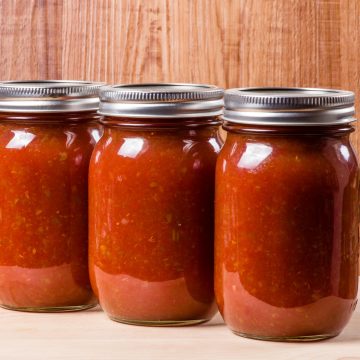
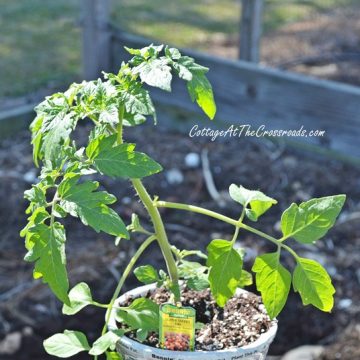
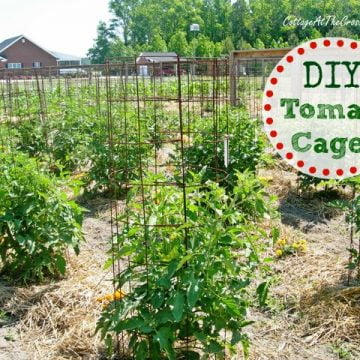

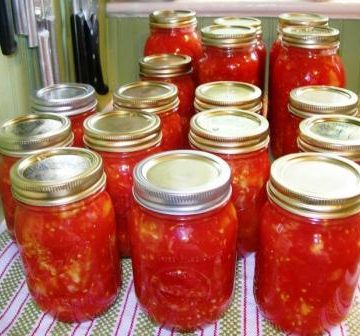

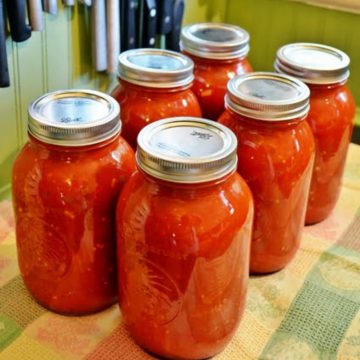
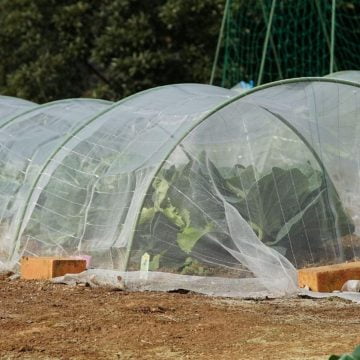
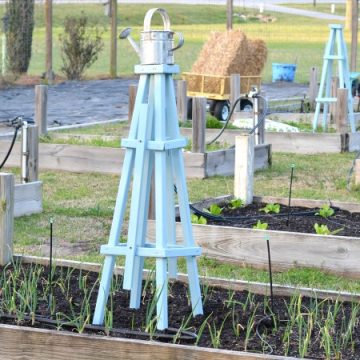


Comments
No Comments